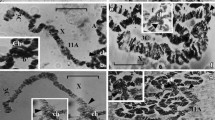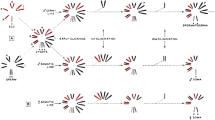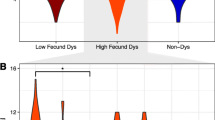Abstract
Mapping of pairing sites involved in meiotic homolog disjunction in Drosophilahas led to conflicting hypotheses about the nature of such sites and the role of heterochromatin in meiotic pairing. In the female-specific distributive system, pairing regions appear to be exclusively heterochromatic and map to broad regions encompassing many different sequences. In male meiosis, autosomal pairing sites appear to be distributed broadly within euchromatin but to be absent from heterochromatin, whereas the X-pairing site maps in the centric heterochromatin. The X site has been shown to coincide with the intergenic spacer (IGS) repeats within the rDNA arrays shared between the X and Y. It has not been clear whether the heterochromatic location of this pairing site has any significance. A novel assay for genic modifiers of X–Y chromosome pairing was developed based on the intermediate nondisjunction levels observed in males whose X chromosome lacks the native pairing site but contains two transgenic insertions of single rDNA genes. This assay was used to test several mutations in Su(var)(Suppressor of position effect variegation), PcG(Polycomb-Group) recombination defective, and repair-defective genes. No strong effects on disjunction were seen. However, the tests did uncover several mutations that suppress or enhance the meiotic drive (distorted X-Y recovery ratio) that accompanies X–Y pairing failure.
Similar content being viewed by others
References
Baker B.S. and Carpenter A.T.C.: Genetic analysis of sex chromosome meiotic mutants in Drosophila melanogaster, Genetics 71(1972): 255–286.
Baker S.M., Bronner C.E., Zhang L., Plug A.W., Robatzek M., Warren G., Elliot E.A., Yu J., Ashley T., Arnheim N., Flavell R.A. and Liskay R.M.: Male mice defective in the DNA mismatch repair gene Pms2 exhibit abnormal chromosome synapsis in meiosis, Cell 82(1995): 309–319.
Baker S.M., Plug A.W., Prolla T.A., Bronner C.E., Harris A.C., Yao X., Christie D-M., Monell C., Arnheim N., Bradley A., Ashley T. and Liskay R.M.: Involvement of mouseMlh1 in DNA mismatch repair and meiotic crossing over, Nat. Genet. 13(1996): 336–342.
Bickel S.E., Wyman D.W., Miyazaki W.Y., Moore D.P. and Orr-Weaver T.L.: Identification of ORD, a Drosophilaprotein essential for sister chromatid cohesion, EMBO J. 15(1996): 1451–1459.
Bonven B.J., Gocke E. and Westergaard O.: A high affinity topoisomerase I binding sequence is clustered at DNAase I hypersensitive sites in Tetrahymena R-chromatin, Cell 41(1985): 541–551.
Boyd J.B., Golino M.D., Shaw K.E.S., Osgood C.J. and Green M.M.: Third chromosome mutagen-sensitive mutants of Drosophila melanogaster, Genetics 97(1981): 607–623.
Boyd J.B., Mason J.M., Yamamoto A.H., Brodberg R.K., Banga S.S. and Sakaguchi K.: A genetic and molecular analysis of DNA repair in Drosophila, J. Cell. Sci. Suppl. 6(1987): 39–60.
Brodsky M. and Rubin G.: mus304encodes a novel checkpoint protein required during multiple stages of development, A. Dros. Res. Conf. 40(1999): 130.
Carpenter A.T.C.: Synaptonemal complex and recombination nodules in wild-type Drosophila melanogasterfemales, Genetics 92(1979): 511–541.
Coen E.S. and Dover G.A.: Multiple polI initiation sequences in rDNA spacers of Drosophila melanogaster, Nucl. Acids Res. 10(1982): 7017–7026.
Cook K.R., Murphy T.R., Nguyen T.C. and Karpen, G.H.: Identification of trans-acting genes necessary for centromere function in Drosophila melanogasterusing centromeredefective minichromosomes, Genetics 145(1997): 737–747.
Craymer L.: Techniques for manipulating chromosome rearrangements and their application to Drosophila melanogaster. I. Pericentric inversions, Genetics 99(1981): 75–97.
Dernburg A.F., Daily D.R., Yook K.J., Corbin J.A., Sedat J.W. and Sullivan W.: Selective loss of sperm bearing a compound chromosome in the Drosophilafemale, Genetics 143(1998): 1629–1642.
Dernburg A.F., Sedat J.W. and Hawley R.S.: Direct evidence of a role for heterochromatin in meiotic chromosome segregation, Cell 86(1996): 135–146.
Engels W.R., Preston C.R. and Johnson-Schlitz D.: Longrange cispreference in DNA homology search over the length of a Drosophilachromosome, Science 263(1994): 1623–1625.
Fanti L., Giovinazzo G., Berloco M. and Pimpinelli S.: The heterochromatin protein 1 prevents telomere fusions in Drosophila, Molec. Cell 2(1998): 527–538.
Gethmann R.C.:Meiosis in male Drosophila melanogaster. II. Nonrandom segregation of compound second chromosomes, Genetics 83(1976): 743–751.
Ghabrial A.R., Ray R.P. and Schupbach T.: okraand spindle-Bencode components of the RAD52DNA repair pathway and affect meiosis and patterning in Drosophilaoogenesis. Genes Devel. 12: (1998), 2711–2723.
Green M.M.: On the meiotic effect of mutants ats the mutagensensitive locus, mus(3)304, in Drosophila melanogaster, Biol. Zentralbl. 101(1982): 223–226.
Grell R.F.: Distributive pairing. In: Novitski N. and Ashburner M (eds), Genetics and Biology of Drosophila 1aAcademic Press, New York, 1976, pp. 435–486.
Hardy R.W., Lindsley D.L., Livak K.J., Lewis B., Silversten A.L., Joslyn G.L., Edwards J. and Bonaccorsi S.: Cytogenetic analysis of a segment of the Y chromosome of Drosophila melanogaster, Genetics 107(1984): 591–610.
Harris P.V., Mazina O.M., Leonhardt E.A., Case R.B., Boyd J.B. and Burtis K.C.: Molecular cloning of Drosophila mus308, a gene involved in DNA cross-link repair with homology to prokaryotic DNA polymerase I genes, Mol. Cell. Biol. 16(1996): 5764–5771. 92
Hawley R.S.: Chromosome sites necessary for normal levels of meiotic recombination. I. Existence and mapping of the sites, Genetics 94(1980): 625–646.
Hawley R.S.: Exchange and chromosomal segregation in eucaryotes. In: Kucherlapati R. and Smith R.R. (eds), Genetic Recombination. American Society for Microbiology, Washington, D.C., 1988, pp. 497–527.
Hawley R.S., Irick H., Zitron A.E., Haddox D.A., Lohe A., New C., Whitley M. D., Arbel T., Jang J., McKim K. and Childs G.: There are two mechanisms of achiasmate segregation in Drosophilafemales, one of which requires heterochromatic homology, Devel. Genet. 13(1992): 440–467.
Hawley R.S., McKim K.S. and Arbel T.: Meiotic segregation in Drosophila melanogasterfemales: molecules, mechanisms and myths, Annu. Rev. Genet. 27(1993): 281–317.
Hayashi S., Ruddell A., Sinclair D.A.R. and Grigliatti T.: Chromosomal structure is altered by mutations that suppress or enhance position effect variegation, Chromosoma 99(1990): 391–400.
Hilliker A.J., Holm D.G. and Appels R.: The relationship between heterochromatic homology and meiotic segregation of compound second autosomes during spermatogenesis in Drosophila melanogaster, Genet. Res. Camb. 39(1982): 157–168.
Ivy J.: Mutations that disrupt meiosis in males of Drosophila melanogaster, Ph.D.thesis (1981), University of California at San Diego, La Jolla, CA.
Karpen G.H., Le M.-H. and Le H.: Centric heterochromatin and the efficiency of achiasmate disjunction in Drosophilafemale meiosis, Science 273(1996): 118–122.
Keeney S, Giroux C.N. and Kleckner N.: Meiosis-specific DNA double-strand breaks are catalyzed by Spo11, a member of a widely conserved protein family, Cell 88(1997): 375–384.
Kerrebrock A.W., Miyazaki W.Y., Birnby D. and Orr-Weaver T.L.: The Drosophila mei-S332gene promotes sisterchromatid cohesion in meiosis following kinetochore differentiation, Genetics 130(1992): 827–841.
Lichten M. and Goldman A.S.H.: Meiotic recombination hotspots, Annu. Rev. Genet. 29(1995): 423–444.
Lifton R.P., Goldberg M.L., Karp R.W. and Hogness D.S.: The organization of the histone genes in Drosophila melanogaster: functional and evolutionary implications, Cold Spring Harbor Symp. Quant. Biol. 42(1977): 1047–1051.
Lindsley D.L. and Zimm G.: The Genome of Drosophila Melanogaster. Academic Press. New York, London, 1972.
Livak K.J.: Organization and mapping of a sequence on the Drosophila melanogasterX and Y chromosomes that is transcribed during spermatogenesis, Genetics 107(1984): 611–634.
McKee B.D.: Sex chromosome meiotic drive in Drosophila melanogastermales, Genetics 106(1984): 403–422.
McKee B.D.: The license to pair: identification of meiotic pairing sites in Drosophila, Chromosoma 105(1996): 135–141.
McKee B.D.: Pairing sites and the role of chromosome pairing in meiosis and spermatogenesis inmale Drosophila, Curr. Top. Devel. Biol. 37(1998): 77–115.
McKee B.D., Habera L. and Vrana J.A.: Evidence that intergenic spacer repeats of Drosophila melanogasterrRNA genes function as X–Y pairing sites in male meiosis, and a general model of achiasmatic pairing, Genetics 132(1992): 529–544.
McKee B.D., Hong C.-S. and Yoo S.:Meiotic pairing sites and genes involved in segregation of the X and Y chromosomes of Drosophila melanogaster, Chromosomes Today 13(2000): 139–152.
McKee B.D. and Karpen G.H.: Drosophilaribosomal RNA genes function as an X–Y meiotic pairing site during male meiosis, Cell 61(1990): 61–72.
McKee B. and Lindsley D.L.: Inseparability of Xheterochromatic functions responsible for X:Y pairing, meiotic drive, and male fertility in Drosophila melanogastermales, Genetics 116(1987): 399–407.
McKee B.D., Lumsden S.E. and Das S.: The distribution of male meiotic pairing sites on chromosome 2 of Drosophila melanogaster: Meiotic pairing and segregation of 2-Y transpositions, Chromosoma 102(1993): 180–194.
McKee B.D., Ren X.-J. and Hong C.-S.: A recA-like gene in Drosophila melanogasterthat is expressed at high levels in female but not male meiotic tissues, Chromosoma 104(1996): 479–488.
McKee B.D., Wilhelm K., Merrill C. and Ren X.-J.: Male sterility and meiotic drive associated with sex chromosome rearrangements in Drosophila: Role of X-Y pairing, Genetics 149(1998): 143–155.
Merrill C.J., Chakravarti D., Habera L., Das S., Eisenhour L. and McKee B.D.: Promoter-containing ribosomal DNA fragments function as X-Y meiotic pairing sites in D. melanogastermales, Devel. Genet. 13(1992): 468–484.
McKim K.S. and Hayashi-Hagihara A.: mei-W68in Drosophila melanogasterencodes a Spo11 homolog: evidence that the mechanism for initiating meiotic recombination is conserved, Genes Devel. 12(1998): 2932–2942.
Miklos G.L.G.: Sex chromosome pairing and male fertility, Cytogenet. Cell Genet. 13(1974): 558–577.
Moore D.P., Miyazaki W.Y., Tomkiel J.E. and Orr-Weaver T.L.: Double or nothing: a Drosophilamutation affecting meiotic chromosome segregation in both females and males, Genetics 136(1994): 953–964.
Palumbo G., Bonnacorsi S., Robbins L. and Pimpinelli S.: Genetic analysis of Stellateelements of Drosophila melanogaster, Genetics 138(1994): 1181–1197.
Peacock W.J.: Nonrandom segregation of chromosomes in Drosophilamales, Genetics 51(1965): 573–583.
Peacock W.J., Miklos G.L.G. and Goodchild D.J.: Sex chromosome meiotic drive systems in Drosophila melanogaster: I. Abnormal spermatid development in males with a heterochromatin deficient X chromosome (sc4sc8), Genetics 79(1975): 613-634.
Pimpinelli S. and Dimitri P.: Cytogenetic analysis of segregation distortion in Drosophila melanogaster: the cytological organization of the Responder (Rsp)locus, Genetics 121(1989): 765–772.
Pirrotta V.: Polycombing the genome: PcG, trxG, and chromatin silencing, Cell 93(1998): 333–336.
Ren X.-J., Eisenhour L., Hong C.-S., Lee Y. and McKee B. D.: Roles of rDNA spacer and transcription unit sequences in X– Y meiotic pairing in Drosophila melanogaster, Chromosoma 106(1997): 29–36.
Sandler L., Lindsley D.L., Nicoletti B. and Trippa G.: Mutants affecting meiosis in natural populations of Drosophila melanogaster, Genetics 60(1968): 525–558.
Sekelsky J.J., McKim K.S., Messina L., French R.L., Hurley W.D., Arbel T., Chin G.M., Deneen B., Force S.J., Hari K.L., Jang J.K., Laurencon A.C., Madden L.D., Matthies H.J., Milliken D.B., Page S.L., Ring A.D., Wayson S.M., Zimmerman C.C. and Hawley R.S.: Identification of novel Drosophila 93 meiotic genes recovered in a P-element screen, Genetics 148(1999): 529–542.
Shao Z., Raible F., Mollaaghababa R., Guyon J.R., Wu CT., Bender W. and Kingston R.E.: Stabilization of chromatin structure by PRC1, a Polycomb complex, Cell 98(1999): 37–46.
Shinohara A., Ogawa H. and Ogawa T.: Rad51 protein involved in repair and recombination in S. cerevisiae is a RecA-like protein, Cell 69(1992): 457–470.
Sun X., Wahlstrom J. and Karpen G.: Molecular structure of a functional Drosophilacentromere, Cell 91(1997): 1007– 1019.
Tartof K.D., Bishop C., Jones M., Hobbs C.A. and Locke J.: Towards an understanding of position effect variegation, Dev. Genet. 10(1989): 162–176.
Wallrath L.L.: Unfolding the mysteries of heterochromatin, Curr. Opin. Genet. Devel. 8(1998): 147–153.
Wu C.I., Lyttle T.W., Wu M.L. and Lin G.F.: Association between a satellite DNA sequence and the Responder of Segregation Distorterin Drosophila melanogaster, Cell 54(1988): 179–189.
Wu C.T. and Howe M.: A genetic analysis of the suppressor 2 of zeste complex of Drosophila melanogaster, Genetics 140(1995): 139–181.
Author information
Authors and Affiliations
Rights and permissions
About this article
Cite this article
McKee, B.D., Hong, Cs. & Das, S. On the Roles of Heterochromatin and Euchromatin in Meiosis in Drosophila: Mapping Chromosomal Pairing Sites and Testing Candidate Mutations for Effects on X–Y Nondisjunction and Meiotic Drive in Male Meiosis. Genetica 109, 77–93 (2000). https://doi.org/10.1023/A:1026536200594
Issue Date:
DOI: https://doi.org/10.1023/A:1026536200594




